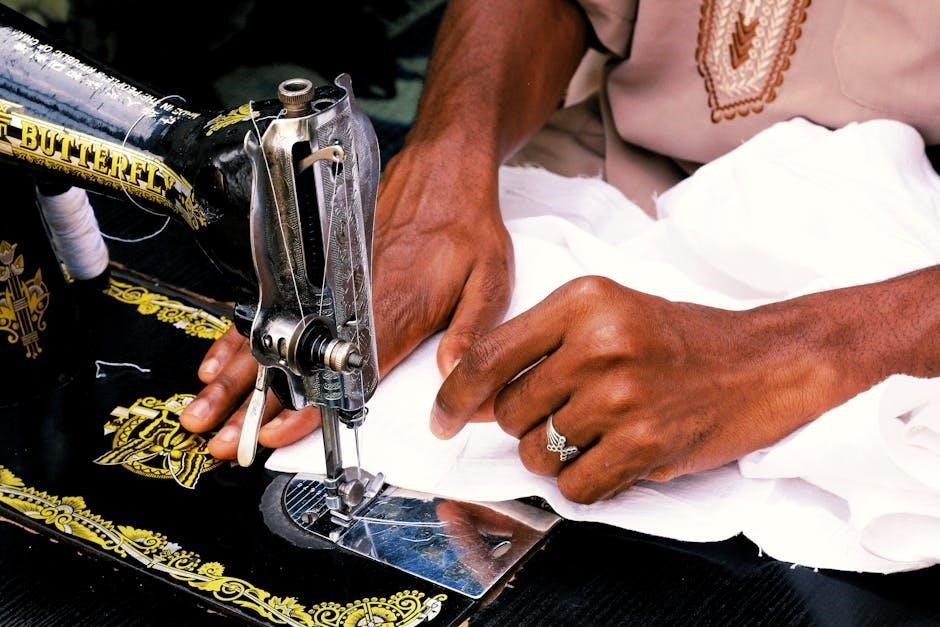Vintage sewing machine manuals are invaluable resources for maintaining, restoring, and troubleshooting classic machines. They provide detailed instructions, parts lists, and historical insights, essential for enthusiasts and collectors.
What Are Vintage Sewing Machine Manuals?
Vintage sewing machine manuals are original or reproduced guides for operating, maintaining, and repairing classic sewing machines. They typically include detailed instructions, diagrams, and parts lists specific to each model. These manuals are essential for understanding the unique features, stitch capabilities, and mechanical workings of older machines. Many are now digitized and shared online by enthusiasts and organizations, preserving their utility for modern sewists. They often cover troubleshooting, maintenance routines, and tips for restoring machines to optimal condition. Whether for a Singer Featherweight or a Husqvarna Viking, these manuals are invaluable for collectors and crafters seeking to revive and utilize vintage equipment effectively.
Why Are These Manuals Important for Sewing Enthusiasts?
Vintage sewing machine manuals are crucial for enthusiasts as they offer step-by-step guidance for operation, maintenance, and repair. These resources help users understand the unique capabilities of their machines, such as specific stitch types and material handling. Manuals also provide troubleshooting solutions, which are essential for addressing common issues like stitch errors or mechanical malfunctions. Additionally, they preserve historical sewing techniques and the legacy of classic machines, making them invaluable for collectors and crafters. By following these guides, enthusiasts can extend the life of their vintage machines and ensure they function optimally, whether for personal projects or professional use. This practical knowledge bridges the past with modern sewing practices, fostering a deeper appreciation for traditional craftsmanship.
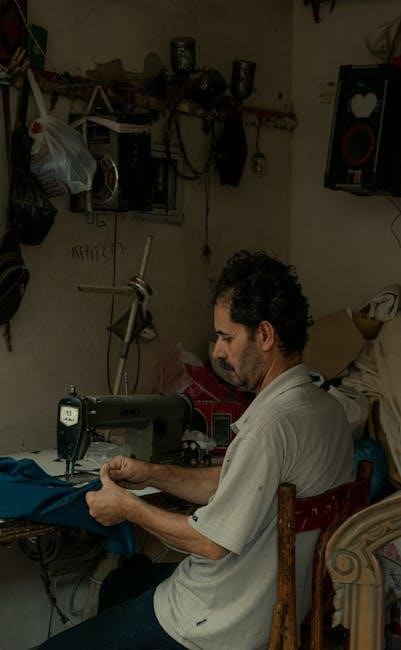
Popular Vintage Sewing Machine Models and Their Manuals
Models like the Singer 221 Featherweight and Husqvarna Viking Class 71 are highly sought after for their durability and unique features, with manuals providing essential operation and maintenance guidance.
Singer 221 Featherweight: A Classic Portable Sewing Machine
The Singer 221 Featherweight is a beloved vintage sewing machine known for its portability and versatility. Introduced in the 1930s, it became a favorite among home sewers due to its lightweight aluminum construction and reliable performance. This model is particularly praised for its straight-stitch capability and ease of use. The Featherweight’s manual provides detailed guidance on threading, tension adjustment, and maintaining the machine. Many enthusiasts appreciate its durability and the fact that it remains functional even decades later. Manuals for the Singer 221 Featherweight are widely available, often shared by collector communities and vintage sewing groups. This model is a testament to the timeless appeal of vintage sewing machines, offering both practicality and charm for modern sewers and collectors alike.
Husqvarna Viking Class 71: A Rotary Electric Vintage Model
The Husqvarna Viking Class 71 is a rotary electric sewing machine from the mid-20th century, celebrated for its durability and versatility. Known for its single rotary hook design, it excels at straight-stitch sewing and is favored for heavy-duty projects like denim and leather. The manual for this model provides detailed instructions on operation, maintenance, and troubleshooting. Enthusiasts appreciate its robust construction and consistent performance, making it a sought-after collector’s item. Manuals for the Class 71 are often found online, shared by vintage sewing communities and organizations like the International Sewing Machine Collectors Society. These resources are invaluable for preserving the functionality and heritage of this iconic machine, ensuring it remains a beloved tool for both practical use and nostalgic appeal.
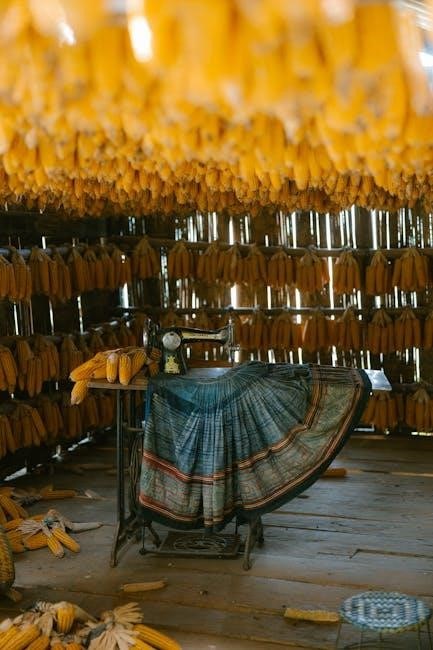
Where to Find Free Downloadable Vintage Sewing Machine Manuals
Free downloadable vintage sewing machine manuals can be found on websites like ISMACS, Facebook groups, and manufacturer archives, offering PDF versions for easy access and preservation.
International Sewing Machine Collectors Society (ISMACS)
The International Sewing Machine Collectors Society (ISMACS) is a premier resource for vintage sewing machine enthusiasts. It offers a vast library of free downloadable manuals, organized by machine class and model. These manuals are scanned from original documents and converted to PDF format for easy access. ISMACS also provides serial number guides, helping users identify and date their machines. Additionally, the site features image galleries and detailed historical information. Members and non-members alike can benefit from the wealth of knowledge shared within the community. ISMACS is particularly useful for those seeking rare or hard-to-find manuals, making it an indispensable tool for collectors, restorers, and sewing historians. Its comprehensive archives ensure that vintage sewing machine knowledge is preserved for future generations.
Facebook Groups and Communities for Vintage Sewing Machine Enthusiasts
Facebook groups have become vibrant hubs for vintage sewing machine enthusiasts, offering a wealth of resources and camaraderie. These communities often share free downloadable manuals, repair tips, and links to rare documents. Members frequently post about their restoration projects, asking for advice and showcasing their successes. Many groups are dedicated to specific brands or models, such as Singer or Husqvarna Viking, while others cater to general vintage sewing machine discussions. These platforms foster connections among collectors and hobbyists, creating a supportive environment for learning and sharing. Additionally, some groups provide access to scanned manuals donated by members, ensuring that valuable information is preserved and accessible to all. Joining these communities is a great way to expand your knowledge and network with like-minded enthusiasts.
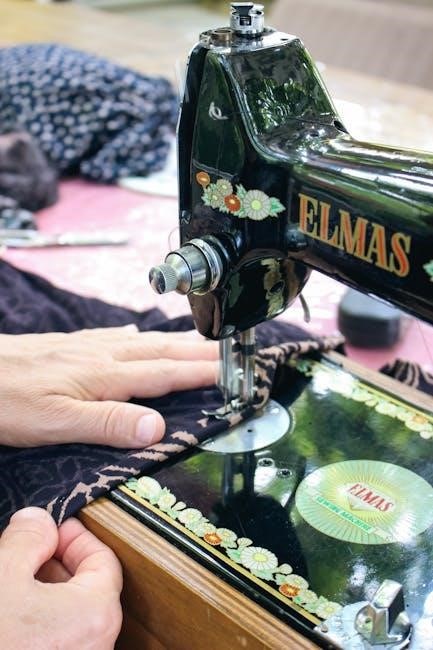
Paid Resources for Vintage Sewing Machine Manuals
Platforms like eBay and Etsy offer rare and original manuals for purchase, while specialty stores and antique dealers provide unique, high-quality vintage sewing machine resources.
eBay and Etsy: Platforms for Rare and Original Manuals
eBay and Etsy are go-to platforms for sourcing rare and original vintage sewing machine manuals. These marketplaces host a wide variety of listings, catering to collectors and enthusiasts seeking specific models. Users can search for manuals by brand, model number, or year, often finding complete, high-quality scans or original booklets. Many sellers specialize in vintage sewing items, ensuring authenticity and rarity. Additionally, these platforms provide a space for community interaction, with sellers sometimes offering restoration tips or repair guidance alongside their listings. For those willing to invest, eBay and Etsy offer a treasure trove of rare manuals that can breathe new life into antique machines.
Specialty Stores and Antique Dealers
Specialty stores and antique dealers are excellent sources for rare and original vintage sewing machine manuals. These businesses often carry a curated selection of manuals, many of which are difficult to find elsewhere. Some dealers specialize in vintage sewing machines and include original manuals with purchases. Additionally, they may offer reproduction manuals or digitized versions for convenience. Visiting these stores allows enthusiasts to inspect items before buying, ensuring authenticity and quality. Many dealers also provide personalized service, offering insights and advice for collectors. For those seeking a unique or hard-to-find manual, specialty stores and antique dealers are invaluable resources, combining rare finds with expert knowledge and a passion for preserving sewing history.

Maintenance and Restoration Tips from Vintage Manuals
Vintage manuals provide essential tips for cleaning, lubricating, and restoring sewing machines. They outline step-by-step processes for maintaining optimal performance and repairing worn parts effectively.
Basic Maintenance: Cleaning and Lubricating Your Machine
Cleaning and lubricating are essential for keeping vintage sewing machines in optimal condition. Manuals often detail specific steps to remove dust, oil residue, and debris from internal mechanisms. Regularly wiping down the machine with a soft cloth and applying a few drops of sewing machine oil to moving parts ensures smooth operation. Pay special attention to the bobbin area, tension discs, and needle bar, as these areas tend to accumulate lint and dirt. Lubrication should be done sparingly to avoid attracting more dust. Always use high-quality sewing machine oil, as specified in the manual, to prevent damage to the machine’s finish or internal components.
Proper maintenance not only extends the machine’s lifespan but also ensures consistent stitching and performance. By following the manual’s guidance, enthusiasts can preserve their vintage sewing machines for years of reliable use.
Advanced Restoration: Replacing Parts and Adjusting Mechanisms
Advanced restoration of vintage sewing machines often involves replacing worn or damaged parts and fine-tuning internal mechanisms. Manuals provide detailed diagrams and step-by-step instructions for disassembling and reassembling components like gears, tension assemblies, and bobbin cases. Replacing parts requires precision to ensure compatibility and proper function. Adjusting mechanisms, such as the take-up lever or stitch length regulator, can restore the machine’s performance to its original specifications. Lubrication with period-specific oils is crucial to maintain smooth operation. Enthusiasts should always reference the manual for guidance on sourcing authentic or reproduction parts. Properly executed restorations not only preserve the machine’s functionality but also its historical integrity, making it a treasured possession for generations of sewers.
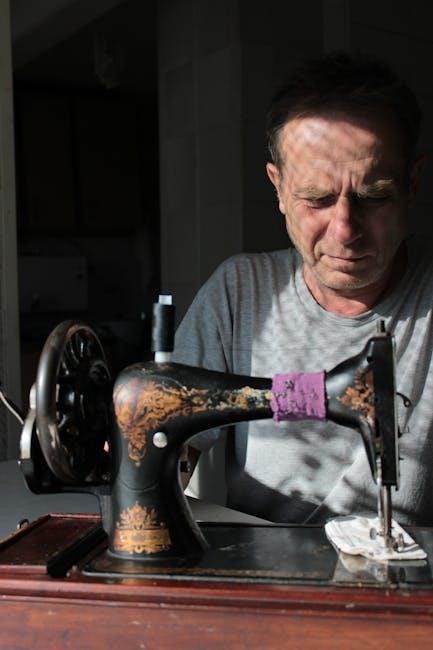
Troubleshooting Common Issues with Vintage Machines
Vintage sewing machine manuals offer solutions for common issues like stitch errors and worn parts, helping users diagnose and repair problems effectively to restore functionality.
Identifying and Fixing Stitch Errors
Vintage sewing machine manuals are crucial for diagnosing and resolving stitch-related issues. Common problems include uneven stitching, skipped stitches, or fabric dragging. Manuals provide step-by-step guides to identify root causes, such as incorrect needle size, improper thread tension, or misaligned bobbin cases. They often include diagrams and troubleshooting charts to help users pinpoint issues quickly. For instance, if stitches are loose, the manual may suggest adjusting the tension dials or re-threading the machine. Additionally, these manuals offer tips for maintaining consistent stitch quality, ensuring optimal performance. By following the instructions, users can restore their machine’s functionality and achieve professional-grade sewing results. These resources are indispensable for both novices and experienced sewists working with vintage equipment.
Repairing or Replacing Worn-Out Parts
Vintage sewing machine manuals are essential for addressing worn-out parts, a common issue in older models. These guides often include detailed diagrams and step-by-step instructions for diagnosing and replacing components like gears, belts, and bobbin cases. For instance, manuals may explain how to repair or replace tension discs, feed dogs, or shuttle hooks, which frequently wear out. They also provide advice on lubricating moving parts to prevent further damage. Many manuals emphasize the importance of using authentic or compatible replacement parts to maintain the machine’s performance. Additionally, they may offer tips for identifying when a part is beyond repair and needs to be replaced entirely. By following these instructions, users can extend the life of their vintage sewing machines and ensure they continue to function smoothly. These resources are invaluable for enthusiasts seeking to preserve their machines’ functionality and heritage.
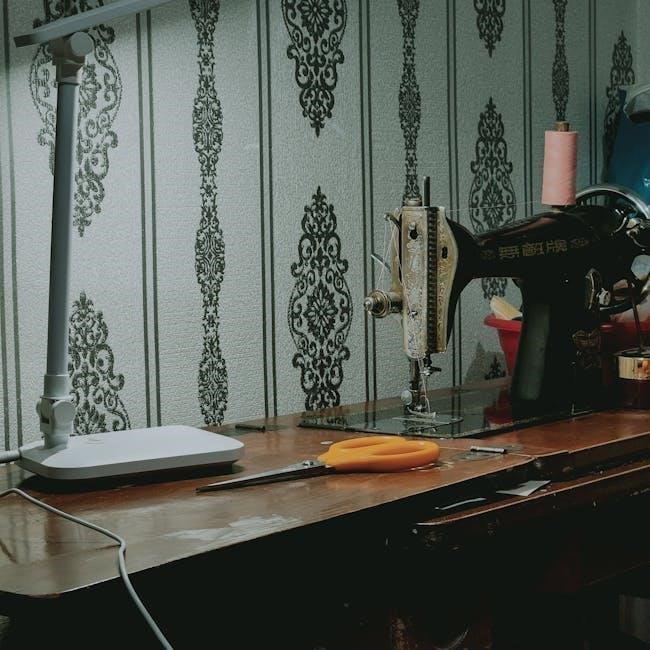
The History of Sewing Machine Manuals
Sewing machine manuals have evolved from basic instruction booklets to comprehensive guides, reflecting technological advancements. Early manuals featured black-and-white illustrations, while modern versions include detailed diagrams and digital formats for easy access.
Evolution of Sewing Machine Technology
The evolution of sewing machine technology is a fascinating journey from mechanical simplicity to computerized complexity. Early models, such as the Singer 221 Featherweight, relied on manual operation and basic stitch functions. Over time, innovations like rotary electric systems in the Husqvarna Viking Class 71 introduced smoother operation and diverse stitch capabilities. The mid-20th century saw the rise of automatic features, such as buttonhole settings and zigzag stitching. Modern machines now incorporate digital controls, memory functions, and advanced materials handling. This technological progression is well-documented in vintage manuals, offering insights into how each generation of sewing machines improved upon the last, catering to both home users and industrial applications.
Design and Content of Vintage Manuals
Vintage sewing machine manuals are renowned for their detailed illustrations, clear typography, and comprehensive instructions. They often feature step-by-step guides for threading, troubleshooting, and performing basic maintenance. Many manuals include diagrams of internal mechanisms, helping users understand how their machines function. Content typically covers stitch types, material compatibility, and accessory usage, making them indispensable for both novice and experienced sewists. The design reflects the era’s emphasis on practicality, with durable binding and high-quality paper. These manuals also serve as historical documents, offering insights into the engineering and design philosophies of their time. Their organized layout and precise language ensure that users can easily navigate and apply the information, preserving the functionality and longevity of their vintage machines.
Collectibility of Vintage Sewing Machine Manuals
Vintage sewing machine manuals are highly sought after for their rarity and historical significance. They often feature original illustrations and detailed instructions, making them valuable to collectors and restorers alike.
Rare and Valuable Manuals for Collectors
Rare vintage sewing machine manuals are highly prized by collectors for their historical significance and often limited availability. Manuals for iconic models like the Singer 221 Featherweight or the Husqvarna Viking Class 71 are particularly sought after. These manuals, especially those in pristine condition, can command high prices at auctions or among enthusiasts. Their value lies not only in their utility for restorers but also in their nostalgic appeal and detailed illustrations. Certain manuals, such as those for early electric or treadle machines, are considered rare gems. Collectors often scour antique shops, estate sales, and online marketplaces to find these treasured documents, which serve as windows into the past of sewing technology and design. Their rarity makes them true collector’s items, cherished for both practical and sentimental reasons.
The Role of Manuals in Preserving Sewing History
Vintage sewing machine manuals play a crucial role in preserving the history of sewing by documenting the evolution of technology, design, and techniques. These manuals serve as historical records, detailing how early machines operated, their stitch capabilities, and the materials they could handle. They often include original diagrams and instructions that provide insights into the engineering and craftsmanship of the time. By preserving these documents, enthusiasts and historians can trace the development of sewing machines from mechanical to electric models. Additionally, manuals often contain tips and tricks passed down through generations, offering a window into the practices of earlier sewists. Their historical significance extends beyond practical use, making them invaluable for understanding the cultural and technological advancements in sewing over the centuries.
